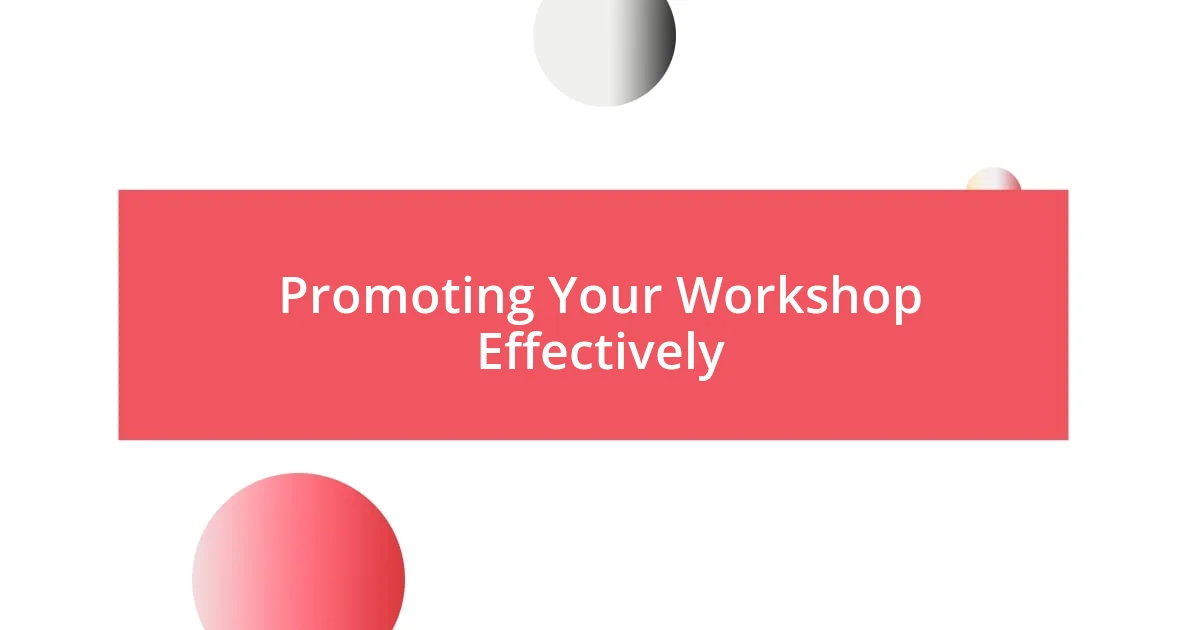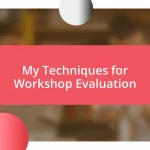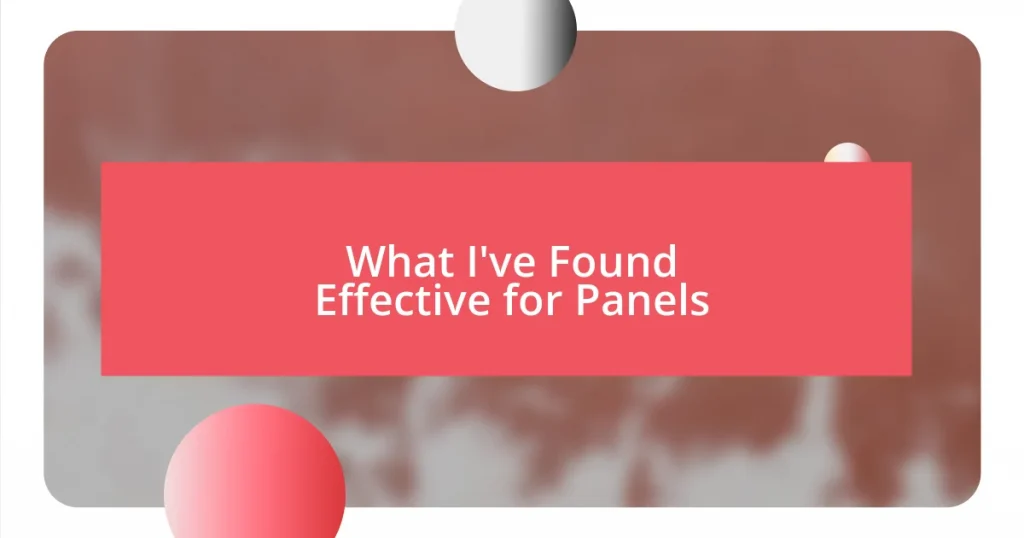Key takeaways:
- Defining clear objectives and understanding participants’ needs leads to focused and memorable workshops.
- Identifying the target audience allows for tailored content that resonates and fosters engagement.
- Evaluating feedback post-workshop is crucial for continuous improvement and creating more engaging experiences in the future.

Understanding Workshop Objectives
When I first started hosting workshops, I realized that defining clear objectives was pivotal to my success. I remember sitting down, staring at a blank page, and asking myself, “What do I really want my participants to take away from this?” This thought process turned my workshops from vague ideas into focused learning experiences.
Setting objectives isn’t just about outlining topics; it’s about creating a roadmap for transformation. For instance, during one workshop focused on public speaking, my goal was for participants not only to understand the mechanics of effective communication but also to feel confident enough to apply these skills immediately. I could see a shift in the room when I shared my own early struggles with public speaking—the vulnerability opened up a space where others felt safe to express their fears too.
Have you ever left a workshop feeling unsatisfied because it didn’t meet your expectations? I remember one such experience, and it drove home the importance of setting realistic, tangible objectives. The clarity I now strive for ensures that participants leave not just with knowledge, but with actionable skills and a sense of accomplishment. It’s this emotional connection to learning that truly makes a workshop memorable.

Identifying Your Target Audience
Identifying your target audience is a critical step that can dramatically shape the success of your workshop. I remember the first time I assumed a broad audience, aiming to please everyone, only to realize later that my message was lost in translation. By defining who I was really speaking to, I could tailor my content to resonate deeply with that specific group, leading to a more engaging experience for both me and the participants.
To effectively identify your target audience, consider the following aspects:
- Demographics: Age, gender, education level, and profession can influence how you present content.
- Interests and Needs: Understanding what drives your audience helps in crafting relevant material.
- Previous Experience: Knowing their background allows you to pitch your information at the right level.
- Challenges: Recognizing the obstacles they face can help you provide actionable solutions.
- Learning Styles: People absorb information differently; some prefer visuals, while others respond better to hands-on activities.
By taking the time to pinpoint these elements, you set the stage for a workshop that truly connects with your audience’s needs and aspirations.

Choosing the Right Workshop Format
Choosing the right workshop format can significantly influence the energy and effectiveness of the entire session. From my experience, I’ve discovered that different formats cater to various learning styles and objectives. For instance, a hands-on workshop worked wonders when I aimed for practical skills, as participants thrived on real-time practice rather than just passive listening. Have you tried mixing formats? I once combined a lecture with breakout sessions, and the shift in engagement was palpable—participants were not just absorbing information, but also applying it in small groups.
I’ve often found that the environment greatly impacts how information is received. In smaller, more intimate settings, I noticed participants were more willing to share their thoughts and engage in discussions. This was especially true during a workshop on creative problem-solving, where collaboration was key. Conversely, larger groups lend themselves well to lectures and demonstrations, where sharing knowledge is more straightforward. It’s a balancing act; knowing when to facilitate discussion versus directly imparting knowledge can make all the difference.
While I was hesitant about virtual formats initially, I realized that they also offer unique advantages, such as reaching a broader audience and leveraging technology for interactive elements. Once, a webinar on digital marketing drew participants from various continents—how fascinating! This diversity enriched our discussions and provided fresh perspectives that I hadn’t anticipated. Choosing the right format is less about the latest trends and more about what aligns with your goals and your audience’s needs.
| Workshop Format | Pros |
|---|---|
| Hands-On | Enhances practical skills, fosters collaboration, and boosts engagement. |
| Lecture-Based | Efficient for delivering content to larger groups, ideal for foundational knowledge. |
| Breakout Sessions | Encourage participation, focus on specific topics, and support peer learning. |
| Virtual | Wider audience reach, flexibility in participation, and the possibility for diverse interactions. |

Designing Engaging Content
Creating engaging content for a workshop is like preparing a delicious meal; it’s all about the right ingredients. In one instance, I focused on storytelling as a central element in my presentation. By sharing relevant personal experiences, I could see people’s eyes light up as they connected emotionally with the narrative. How often do we remember a point made in a workshop? If it’s tied to a story, it can last a lifetime.
I’ve also found that incorporating interactive elements makes content resonate more. During a session on leadership, I introduced role-playing scenarios, allowing participants to step into someone else’s shoes. The laughter and genuine response were things I hadn’t expected, but they brought the topic to life. Isn’t it fascinating to see theory transform into real-life practice right before your eyes?
Visual aids can further enhance engagement. I once used infographics to simplify complex data during a workshop on market trends. The participants not only grasped the concepts but actively discussed their implications. This experience taught me that when we present information visually, we’re not just feeding data; we’re inviting our audience to take part in a visual conversation. It’s all about igniting curiosity and keeping the dialogue going!

Promoting Your Workshop Effectively
Promoting your workshop effectively is crucial to ensuring attendees fill those seats. One tactic I’ve found particularly successful is leveraging social media. When I hosted a creative writing workshop, I created a series of short videos sharing writing tips and encouraging potential participants to join. The engagement was astounding; it felt like I was fostering a community before the workshop even started. Have you tried showcasing snippets of what participants can expect? It not only piques curiosity but also builds anticipation.
Additionally, partnerships can amplify your outreach. For instance, I once collaborated with a local bookstore to promote my workshop. They shared my event with their audience in exchange for the promise of a special discounted rate for their customers. This mutual benefit not only increased my attendance numbers but reinvigorated interest in the bookstore itself. It was a win-win situation, demonstrating how creative collaborations can be resources for effective promotion.
Lastly, don’t underestimate the power of email marketing. I recall sending personalized invitations to a list of contacts who had expressed interest in previous workshops. The response rate was higher than expected, and several participants told me that a simple reminder was all they needed to commit. It’s so true that a little nudge can go a long way. How are you connecting with your audience? Simple reminders and personal touches can significantly enhance engagement and attendance.

Executing the Workshop Day
Executing a workshop day can be both exhilarating and nerve-wracking. I recall waking up that morning with a rush of excitement fluttering in my stomach. As I set up the room, arranging chairs and testing the tech, I felt a surge of anticipation—what would unfold in those few hours? Those first moments of interaction are crucial, as they set the tone for the entire event.
When the attendees began to arrive, I made it a point to greet each person personally. This small gesture created an immediate sense of welcome and connection. I remember one participant commenting, “I wasn’t sure about coming, but your warm smile made it feel right.” This experience reinforced how a genuine greeting can transform the atmosphere. Doesn’t it make you think about the power of personal touch in human interactions?
As the workshop progressed, I encouraged feedback through quick polls and open discussions. I often asked, “How do you all feel about this concept?” The responses were enlightening. I discovered that the participants brought in a wealth of knowledge and experience that enriched the workshop beyond my initial expectations. This dynamic exchange affirmed my belief: while I may be the facilitator, the real magic happens in the shared insights and connections we build together. It’s a beautiful reminder that we all have something valuable to contribute.

Evaluating Feedback for Improvement
When it comes to evaluating feedback for improvement, I find it essential to approach it with an open mind. After my last workshop, I gathered all the comments, both positive and constructive, and sat down with a cup of tea to reflect. It was surprising to see how certain suggestions echoed my own thoughts during the session. Have you ever realized that sometimes participants can pinpoint areas for improvement even better than you? This realization can be a game-changer.
I made it a practice to categorize the feedback into themes. One memorable piece of advice was about pacing; several participants felt that some sections could have been expedited. I remember how critically I took that input. Instead of feeling defensive, I embraced it, thinking, “What if this is an opportunity to refine my content?” I can’t tell you how liberating it was to view feedback not as criticism but as a valuable roadmap for future workshops.
Moreover, reaching out to attendees for follow-up discussions has been enlightening. One participant once shared how a particular activity sparked inspiration for a project they were struggling with. Hearing that warmed my heart and cemented my belief in the importance of refining my approach based on shared experiences. As I sift through feedback, I continually ask myself: “How can I create a more engaging experience next time?” This question drives my growth and certainly keeps the excitement alive for my future workshops.















